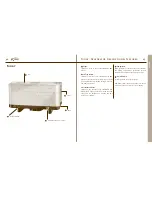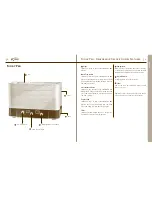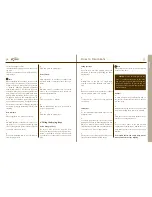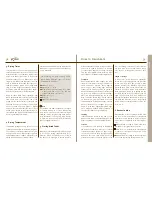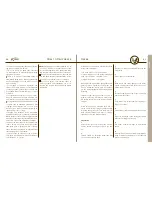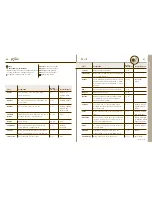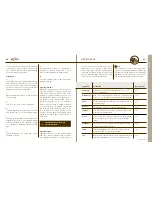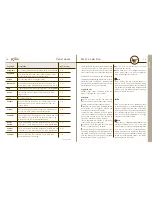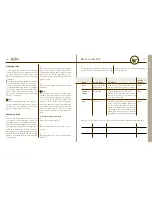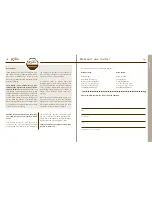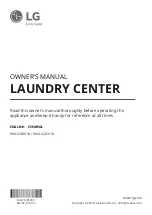
54
55
Dehydrated foods should be stored in an
airtight container.
Benefits of dehydrating food –
what is dehydration?
Dehydration refers to a process in which mois-
ture is removed from food, preventing spoilage,
and allowing dried food to be stored safely for
later use. Few nutrients are lost during dehy-
dration.
Benefits of dehydrating food
The food retains almost all of its nutrients
and taste.
You can control the quality of your food;
preserving food at its nutritional peak.
The weight and size of food is reduced.
There are no worries about spoilage, unlike
frozen foods, if there is a loss of electricity.
Food becomes more energy-dense.
Food is not subjected to extreme high tem-
peratures as in the canning process.
Preparation is easy and the drying process
doesn’t need to be constantly attended.
Dehydrating can be done overnight.
Dehydrated foods are easy to store and
simple to use.
Storing dehydrated foods is energy effi-
cient.
Dehydration concentrates natural flavor,
sweetness and aroma of food.
Since natural sugars concentrate as you
remove moisture, the dried product is natu-
rally sweet. Usually, you won’t need to add
sugar because of this natural sweetness.
How to dehydrate
The only way to become an expert is through
experience. Experiment with various drying
times and temperatures. Record what works
best for you.
Equipment
Sharp paring knife (Use stainless steel blades.
Carbon blades may turn some fruits and veg-
etables dark. A vegetable slicer or electronic
slicer may also be useful.)
Cutting board
Blender (for making leathers and powders)
Storage containers
Optional: Peeler, steamer and basket, or kettle
and collapsible steamer
Before dehydrating, wash hands thoroughly.
Make sure the counter, cutting board, utensils,
equipment and storage containers are clean
prior to using.
Selecting Food
Pick the best quality food at the peak of ripe-
ness and flavor. Cut away any bruised or dam-
aged sections.
Decide Then Dehydrate
Before beginning, decide how dehydrated
food will be used. For example: snacks, baked
goods, soups, sauces or dips. This will help
determine how thick to slice food, whether to
peel or not and whether to salt or season.
To Peel or Not
Peels tend to be tough when dried and take
longer to dry; however, the peels of fruits and
vegetables often contain much of the food’s
nutritional value. Peeling is a personal prefer-
ence. If you would normally peel the food for
a specific recipe, plan to peel the food to be
dehydrated. Peel apples intended for pies or
tomatoes intended for soup. It is better not
to peel, if the dried food is to be eaten as a
snack.
Cutting Makes a Difference
Slice or cut food to uniform thickness. This
allows even drying.
Don’t slice food too thin. 1/4 is preferred for
most fruits and vegetables.
Moisture rich foods such as watermelon, may
need to be sliced thicker to dehydrate properly.
Moisture escapes best from a cut or broken sur-
face, not through tough skin. The larger the cut
area, the faster and better the food dehydrates.
Thin stalked vegetables like green beans,
asparagus or rhubarb should be cut in half
lengthwise, or with an extreme diagonal cut.
Broccoli stems should be halved or quartered,
depending upon diameter.
Fruit should be sliced across the core.
Make thin, flat cuts.
Small fruits like strawberries can be cut in
half. Smaller berries should either be cut in half
or blanched slightly to break the skin.
1. Pretreating
Dipping in a Pretreating Solution
(generally used for fruits)
Some fruits, such as apples, pears, peaches,
apricots and bananas tend to oxidize and dark-
en somewhat during drying or when stored be-
yond 6 – 7 months. To prevent discoloration and
extend shelf life, pretreat as follows:
1
Dipping Solution: We prefer using bottled lem-
on juice, 2 parts juice to 1 part water. You may
also use orange juice, pineapple juice, (fresh or
bottled), fresh lemon juice, ascorbic acid or a
produce protector such as Fruit-Fresh. Ascorbic
acid may be purchased from drug stores. Mix
1 tsp ascorbic acid per quart of water. Follow
label directions for Fruit-Fresh.
2
Allow fruit to sit in pretreating solution for 2 – 5
minutes. Do not leave fruit in the solution for
longer than 10 minutes.
3
Strain through fine mesh strainer before placing
on drying trays.
Blanching / Steaming Benefits
(generally used for vegetables)
Sets color
Stops ripening process (enzymatic action)
ENGLISH
How to Dehydrate
On Dehydration




